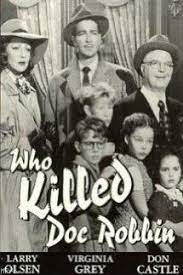
Ann Loring (Virginia Grey) is on trial for murder. She has been accused of killing Doctor Hugo Robbin (George Zucco). The prosecution says she blew up his laboratory and he was killed in the resulting fire. Loring’s attorney, George (Don Castle) is representing her. The trial is interrupted when a group of neighborhood kids claim to have information that is important to the case.
The children, Betty (Eilene Janssen), Dudley (Peter Miles), Speck (Dale Belding), Curley (Larry Olsen), and Ardda (Ardda Lynwood) are finally given a chance to testify. Ardda tells the court that she saw Ann at Fix it Dan’s (Whitford Kane) the day of the explosion. Fix it Dan is the local guy that fixes the children’s toys when they break. When Dan finds out that Curley hurt his toe, he insists that he go to Doc Robbin’s to have him check it out. The others decide to go with him for support.
Curley tells the court that while they were at Doc Robbin’s office, they heard Dan and Robbin arguing. Dan had invented a device that was explosive and could be used as a weapon in the wrong hands. He now feels that Doc Robbin is the wrong hands. Ultimately, the children’s testimony results Dan being accused of killing Doc Robbin instead of Ann.
Determined to prove Dan’s innocence the kids decide to investigate the explosion site. They are looking for the firing chamber that Dan invented to prove it wasn’t the cause of the explosion. They end up finding a passage that takes them into Doc Robbin’s large and spooky mansion. Their search for the firing chamber pits them against a chimpanzee, a gorilla and their own fears.
“Who Killed Doc Robbin” was released in 1948 and was directed by Bernard Carr. It is an American comedy and light mystery. The film was produced by Hal Roach Jr. and Robert F. McGowan.
Hal Roach owned the “Our Gang” series. These were short films that featured children in various predicaments. They were popular from the twenties to the forties. Roach sold the rights to MGM in 1938 with a provision allowing him to buy back the series provided he not do any more kiddie movies. He forfeited that right when he produced “Curley” in 1947 and “Who Killed Doc Robbin” in 1948. These two films used different stars than in the original “Our Gang” shorts. Neither film did very well in theaters.
Roach then turned his attention to television. In 1948 he bought back the rights to the “Our Gang” shorts that he originally did but MGM kept the name as well as the shorts they produced when they owned the series. Roach repackaged his original “Our Gang” shorts for television and renamed them “The Little Rascals”. Eventually others got involved and the “Our Gang”, “Little Rascals” shows ended up bought and sold to various studios and distributors all over television and under different titles.
I’ve never been a fan of “Our Gang”, or its resurrected “Little Rascals”, or any of the other pint size slapstick films. However, if you are a fan of them then you will like this one as well. Is it racist? Of course, it was the forties, and everything was racist. To me, the best part of the film was George Zucco.
The gorilla was played by Charles Gemora.

